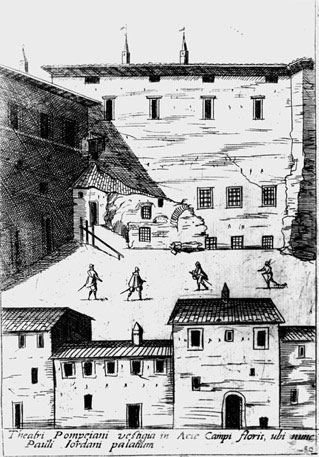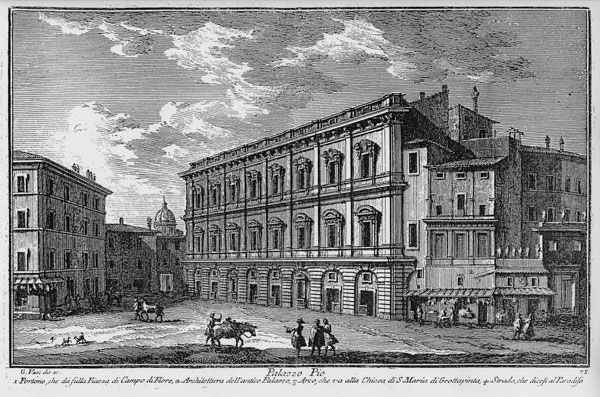The Theater in Antiquity - I
The Theater in Antiquity - II
The Theater in the Middle Ages
The Theater in the Early Modern Era
The Theater in the Modern Era
The Theater in the Early Modern Era
By
Kristin Triff
Soon after the return of the papacy from Avignon in 1420, the
Theater’s location along the papal possesso route (Rome’s
main ceremonial pathway between St. Peter’s and the Lateran)
together with Rome’s improving economic situation, brought a series
of tenants, primarily members of the papal court, to the Orsini
palace. Property in the southern half of the Theater facing
Piazza del Biscione was leased to the Venetian Cardinal Francesco
Condulmer, nephew of pope Eugene IV Condulmer (1431-1447), who built
an elaborately decorated residence around 1450. Towards the
end of the sixteenth century, Duke Virginio Orsini renovated this
area of the palace, adding the distinctive loggia visible in Antonio
Tempesta’s view of 1606. Apart from this area, much of the
Theater was inhabited but remained largely unimproved apart from the
commercial and residential properties that were leased out to
individual tenants.
 |
|
|
| View of Palazzo Osini at Pompey’s Theater (Giovanni
Maggi, c. 1615) |
This period was also one of intense antiquarian interest in the
history of the Theater; as early as 1482, Flavio Biondo’s Roma
Instaurata records the discovery, near the Church of S. Lorenzo
in Damaso, of a large squared stone with the inscription recording
the genius, or spirit, of the Theater of Pompey (genius theatri
pompeiani). This interest is reflected in numerous
Renaissance reconstructions of the Theater by artists, engravers,
and antiquarians including Pirro Ligorio, Giovanni Maggi, and
Giovanni Battista Piranesi.
 |
|
|
|
View of Pompey’s Theater in Antiquity (Giovanni
Maggi, c. 1615) |
Following the sale of the Orsini palace to Prince Alberto Pio
di Savoia da Carpi in 1652, the building wing facing Piazza Biscione
to the north was renovated and enlarged to include a new apartment
and façade, completed by Camillo Arcucci in 1667. This new
wing, which covered the existing façade of Santa Maria in Grotta
Pinta seen in Tempesta’s view of 1606, necessitated the
reorientation of the church toward the Via di Grotta Pinta to the
east.

View of Palazzo
Pio looking southeast (Giuseppe Vasi, 1754)
